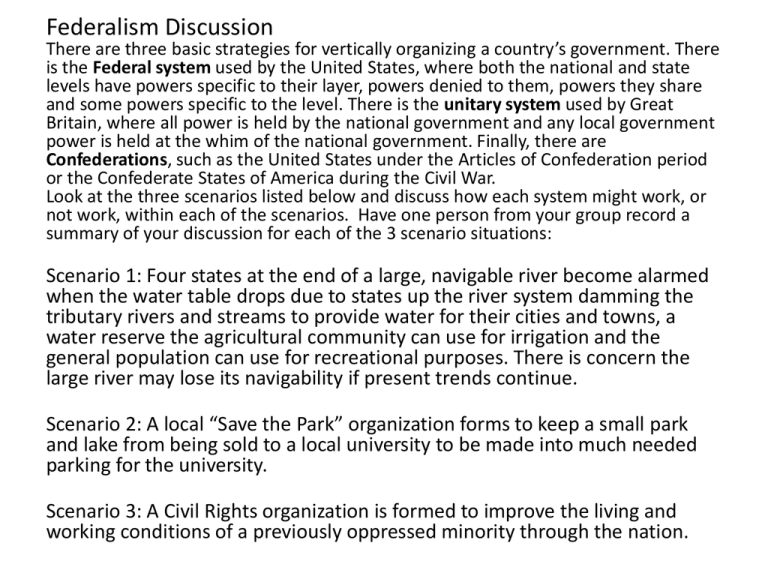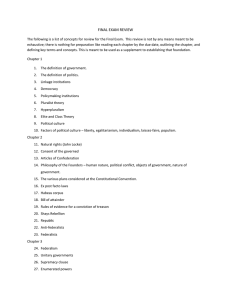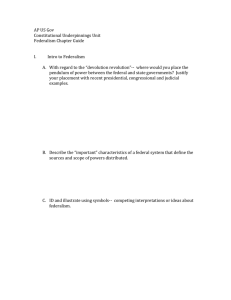File - Mr. Maxey Government
advertisement

Federalism Discussion There are three basic strategies for vertically organizing a country’s government. There is the Federal system used by the United States, where both the national and state levels have powers specific to their layer, powers denied to them, powers they share and some powers specific to the level. There is the unitary system used by Great Britain, where all power is held by the national government and any local government power is held at the whim of the national government. Finally, there are Confederations, such as the United States under the Articles of Confederation period or the Confederate States of America during the Civil War. Look at the three scenarios listed below and discuss how each system might work, or not work, within each of the scenarios. Have one person from your group record a summary of your discussion for each of the 3 scenario situations: Scenario 1: Four states at the end of a large, navigable river become alarmed when the water table drops due to states up the river system damming the tributary rivers and streams to provide water for their cities and towns, a water reserve the agricultural community can use for irrigation and the general population can use for recreational purposes. There is concern the large river may lose its navigability if present trends continue. Scenario 2: A local “Save the Park” organization forms to keep a small park and lake from being sold to a local university to be made into much needed parking for the university. Scenario 3: A Civil Rights organization is formed to improve the living and working conditions of a previously oppressed minority through the nation. Federalism Latin for “Covenant” Federalist supporters of the new constitution argued three points for the new system. 1. Prevents tyranny 2. Helps increase public participation 3. A testing ground for new policy Federalism is… ➢ A system of government in which political authority is divided between a national government, and its political subdivisions (such as states) ➢ In the U.S., the national government and the Constitution are supreme over states the Federalism & the Constitution The Federal Government has implied powers from the necessary & proper clause or “elastic clause” (ex: create a national bank) The U.S. Constitution is the supreme law of the land (National Supremacy Clause) The 10th Amendment reserves powers to the states (ex: education, law enforcement, etc.) The Federal Government has expressed powers specifically granted in the Constitution (tax, regulate commerce, declare war, etc.) Responsibilities of the NATIONAL government to the STATE governments. 1. Guarantee of a representative government. (Article V-provides that the amendment process cannot be used to deny any state equal suffrage or representation in the senate.) 1. Protection against foreign invasion and domestic violence. (Art. IV) 2. Respect for territorial integrity. (Art. IV) 3. Support and financial help. (Art. I Sec. 8) Responsibilities of the STATE governments to the NATIONAL government 1. Conduct national elections. (Art. I Sec. 4) 2. Enforce the laws. (Art. IV) Responsibilities of the STATES to other STATES (Art. IV) 1. 2. 3. 4. 5. No interstate compacts. (Art. I, Sec. 10) Full faith and credit Privileges and immunities Extradition of the accused Admission of new states on equal footing by Congress –Enabling Act and Act of Admission Federalist No. 51 Madison tells us that the shifting support between the two levels will keep each in check….. Federalist No. 28 Alexander Hamilton,, suggested that both levels of government would exercise authority to the citizens' benefit: "If their [the peoples'] rights are invaded by either, they can make use of the other as the instrument of redress." Era’s of Federalism Use your guided notes! Federalism and immigration • http://www.click2houston.com/news/suprem e-court-sets-election-year-clash-onimmigration Federalism & the U.S. Supreme Court McCulloch v. Maryland (1819) ➢Marshall 1) 2) Court’s Decision: National bank constitutional using “necessary & proper clause” States do not have the right to tax a federal institution (“the power to tax is the power to destroy”) based on Supremacy Clause Gibbons v. Ogden (1824) Marshall Court’s Decision: ■Only Congress can regulate interstate commerce Gitlow v. New York (1925) Taft Court’s Decision: ■SCOTUS rules for the first time that the Bill of Rights limits the states as well as the federal government ■Establishes the “Selective Incorporation Doctrine” U.S. v. Lopez (1995) Rehnquist Court’s Decision: ➢ Struck down the Gun-Free-School-Zone Act because Congress exceeded its authority to legislate ➢ Rare victory for the states McDonald v. Chicago (2010) Roberts Court Decision ➢ Struck down Chicago’s strict handgun ban and said the 2nd Amendment can limit the states. Obergefell v. Hodges (2015) Roberts Court Decision: ➢ The 14th Amendment requires States to license a marriage between two people of the same sex ➢ States must recognize a marriage between two people of the same sex when their marriage was lawfully licensed and performed out-of-State. Selective Incorporation ■ ■ ■ a.k.a. The Incorporation Doctrine The legal doctrine by which portions of the Bill of Rights are applied to the states The Due Process Clause of the 14th Amend. What are the merits of a federal system? A federal system: • Offers the means to unify a country at the same time that it respects the uniqueness of the different institutions or levels of government • Supplies the best means of developing a new country in a natural and spontaneous way • Prevents the rise of a despotic central government Federalism and local self-government: • Self-government stimulates the interests of the people; sustains local political life; educates citizens in their duties, teaches perpetual vigilance to attain the goals of a good administration; liberty and collective prosperity • Federalism diminishes risks The Merits of a Federal system cont.. • Federalism enables people to experiment • Federalism distributes power in such a way that it relieves the national legislature of duties that would prove otherwise too heavy for it • The American Constitution provides the national government direct authority over all citizens while at the same time empowering the states as well – Both states and the national government look for mediation through an independent body How did the government get so large? “No one planned the growth, but everyone played a part in it.” Reasons for growth: 1. National or global scope to problems- states could supervise small business but needed national government to oversee national corporations. 2. Industrialization- business groups quickly discovered the national government had more money and assistance than the states. (pre-Civil War national government was distant and foreign) 3. Since Great Depression-welfare, unemployment, agriculture help, WWII regulations of price controls, wages, GI Bill, etc. 4. Politicians-presidents, judges, federal administrators, especially Congress reacts to pressure to create new initiatives and there is rarely a counter pressure. Devolution Revolution “era of big government is over” Send federal functions back to the states--??? Do the states want those responsibilities back or new demands on their budgets? Centralists vs. Decentralists Centralists-those who favor national action. (nationalists) Decentralists- those who favor action at the state and local levels. (states’ righters) The constitutional arguments revolving around federalism grew out of the specific political issues. Did the national government have the authority to outlaw slavery? Did states have the authority to operate racially segregated schools? Could Congress regulate labor relations? Centralists’ Arguments 1. (national government agent of the people/state governments speak for only some!) State and local officials tend to be less competent than national officials. 2. State and local officials tend to be concerned only with the interests of their own areas. 3. State and local governments are unable or unwilling to raise taxes needed to carry out vital government functions. 4. State and local governments are more apt to reflect local racial and ethnic biases, as well as bias toward dominate local industries. 5. State and local government are afraid to regulate industries for fear the industries will move elsewhere. (John Marshall, Lincoln, FDR and historically Supreme Court) Decentralists’ Argument (state governments closer to the people-national government should be an agent of the sovereign states) 1. Increased urbanization has made states more responsive to the needs of the cities. 2. Recently state and local governments have shown greater willingness to raise taxes. 3. State and local governments have become as sensitive to the needs of the poor and minorities as the national government. 4. State and local governments have reformed and modernized and are now more effective. (Jefferson, Reagan, Bush, Rehnquist, Supreme Court 1920-1937)









